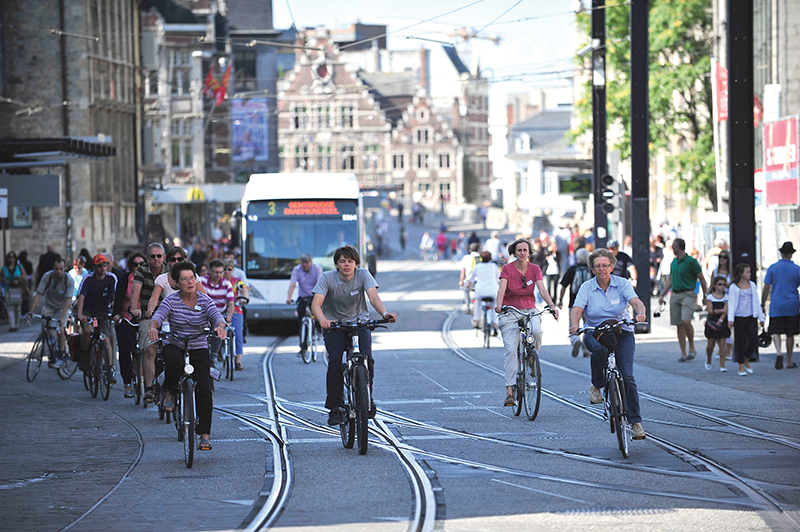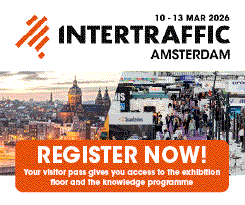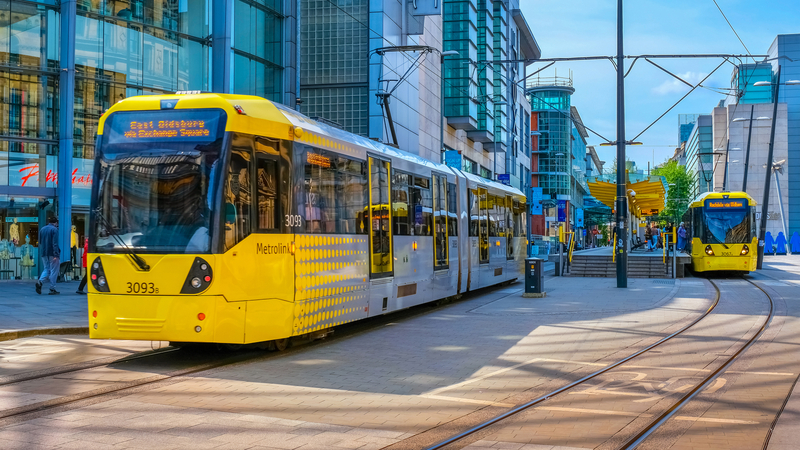
Photo: Karen-Vancluysen-Secretary-General-Polis
Interview: Karen Vancluysen, Secretary General of Polis
20 August 2015
by Nick Michell
Jonathan Andrews spoke to Karen Vancluysen, Secretary General of Polis–the transport network of European cities and regions–about its expanding reach and how data and the sharing economy is dramatically changing how we use transport
Since its inception in 1989 how has the organisation’s work changed, and what have been some of the more successful innovations Polis has helped implement?
Back in 1989, transport practitioners and decision makers from European cities and regions established Polis. They felt the need for a platform to discuss common challenges and innovative solutions on urban transport. This membership-driven, bottom-up approach has remained instrumental to our network. While at the beginning, a lot of emphasis was placed on Intelligent Transport Systems [ITS], the network afterwards gradually opened up to other topics, and has since long been covering a wide and encompassing range of urban mobility themes, linking into environment and health, safety and security, mobility and traffic efficiency, and social and economic aspects of transport.
When it comes to implementing innovations, we have for example played an important role in the deployment of bike-sharing schemes, which we already promoted and helped to implement through the NICHES project in 2004, the development of key performance indicators for ITS, and the use of open standards and systems in traffic management. We have also developed several mechanisms to help shorten the innovation cycle, mainstream niche solutions, and encourage the transfer and take-up of new and promising urban transport measures, for example within the context of the TIDE project that we coordinate (www.tide-innovation.eu).
How can cities join Polis and how is it funded?
Cities and regions interested in joining Polis submit an application form that is presented for approval to the Polis Management Committee. Members pay an annual fee, which is based on the number of inhabitants of the city or region. By becoming a member, cities and regions get full access to the network’s services, which reflect three main strands: the exchange of experience between members and with other relevant stakeholders, mainly through the Polis thematic Working Groups; helping members gain access to European-funded projects in the urban transport field; and finally the representation of cities and regions before the European institutions when it comes to urban mobility matters through our policy activities.
What do your cities believe is the biggest challenge in terms of transport policy and management?
A leading city today from an urban mobility perspective is a city that wants its local mobility to be sustainable so as to offer its citizens a pleasant place to live in while being able to move around freely in a way that does not negatively impact on fellow citizens, their health and overall quality of life. Major challenges in that respect are congestion, air quality and noise. Addressing these challenges sometimes implies taking unpopular and restrictive decisions and therefore political courage. Integrated approaches, delivered through sustainable urban mobility plans which help to link up all relevant policy domains, are required to tackle these challenges, and the smart use of innovations is key in helping cities to reduce the adverse impacts of transport on citizens’ well-being.
Although membership is predominantly open to European cities and regions, you still network with other cities internationally, including those in China, India and Latin America through the SOLUTIONS project. Are sharing experiences with these cities a two-way street?
We see a trend towards more cooperation on the global level by European organisations but also from cities. It is not surprising to us that interest in China, India and Latin America especially is growing, because rapid urbanisation is one major, if not the most important, trend in these countries.
Sharing experiences between Europe and the rest of the world works both ways, as we have realised during the SOLUTIONS project. Motivations may differ–some leading cities do it because they don’t want to miss out on global trends, while others are searching for technological solutions to implement at home. What is clear is that non-European countries are catching up very quickly.
Fast-growing cities in China, for instance, invest heavily in their public transport systems and have the opportunity to implement the latest technologies, such as full-electric buses, on a large scale right from the start. Another example, are South American BRT [bus rapid transit] systems, a cost-effective way to improve public transport. European cities are highly interested in following these developments.
In order to accommodate this growing interest and trend, Polis associated membership is now also open to non-European cities and regions.
Apart from member cities, which other partners do you work with?
Polis is very well connected to all major urban transport stakeholders, whether from industry, research, other European associations or the European institutions. It is instrumental for all these players to join forces, create synergies and pool expertise. Local decision makers and practitioners communicate their policy needs and challenges, to which industry and research stakeholders should respond with products, tools and approaches that help to meet these policy objectives. Market products that do not respond to the concrete needs of cities are not used.
We also represent the voice of cities and regions towards European institutions when it comes to initiatives on that level in the field of urban mobility that may have a direct impact locally. Throughout the years, Polis has become the natural interlocutor for all these partners to discuss relevant urban mobility topics.
BRT and bike share networks have proved to be a low-tech solution that has helped boost the sustainable transport credentials of many cities. What do you think is the next big innovation?
There’s no such thing as one big innovation, or one miracle solution, but what will certainly have a big impact on the way we manage transport in cities, is the huge amount of data that becomes available through the ever expanding digital society, which can inform the way cities plan and manage their traffic. The open data movement is also important, as well as improved and real-time traveller information systems to enhance the user experience and facilitate inter- and multimodality. The sharing economy certainly could significantly change the way we use different transport modes as well.

BRT and bike share networks have grabbed the public’s imagination whereas electromobility has fallen somewhat short. Why is this and do you think electric vehicles’ (EVs) time has passed?
Electromobility, as any other innovation, is facing several challenges when it comes to its further market take-up. These challenges are not only financial or technical; setting favourable, coordinated and coherent policies at EU, national and local level are also crucial to achieve larger EV rollout.
Electromobility is becoming an integral part of local strategies when it comes to addressing for example energy, air quality and noise problems. Within the overarching context of a sustainable urban mobility plan, the role of electric mobility should be reinforced as part of a multimodal system and approach.
Especially for captive fleets, like public transport, car sharing, and urban freight, there’s great potential. That’s precisely what the ZEEUS (electric buses) and FREVUE (electric freight vehicles) projects are looking into at the moment.
So, EVs’ time has not passed, but is rather yet to come. Several European cities and regions have participated in EU- funded pilots and have made resources available to test and deploy EVs. They are leading by example and have integrated EVs in their own fleets, while facilitating their private use and purchase, and investing in the set-up of public charging infrastructure and associated customer services. Still, different governance levels and relevant public and private stakeholders need to work together to coordinate strategies, responsibilities, resources and measures (including awareness raising and communication), with one ultimate and common goal in mind: to have a positive effect on end- users’ mobility behaviour.
Is finance a big consideration when sustainable transport policies are drawn up and shared within your network? And do you work closely with the private sector at large?
Yes, the permanent lack of budget is a big issue for local and regional authorities. Smaller budgets can also be a driver however, a reason to be creative and to carefully select measures in view of their potential contribution to achieving policy goals.
There’s also a general understanding that investment in innovation is needed, that it also brings actual return on investment, and can help to reduce costs and increase efficiency. It is not just the price of a service you should look at, rather we are dealing with a much broader picture, where societal costs and benefits are at stake.
A lot of effort goes into the market deployment of innovation, and the role of cities in that respect: understanding business models, the total cost of ownership, the distribution of financial risk within public-private partnerships, among others. This is part of the new innovation agenda for transport and this indeed requires close cooperation with the private sector, in a research context but also to see how the private sector can help to financially enable implementation.
How can transport assist in the area of safety and security in cities?
Within the transport field, significant safety and security concerns need to be addressed. The objective is to cut road deaths in Europe by half by 2020 compared to 2010. Serious traffic injuries however are eight times higher than road deaths. Within urban areas, 67 percent of reported seriously injured road users are what we call vulnerable road users, including pedestrians and cyclists. A more ambitious strategy is needed, which includes a clear target to reduce serious injuries.
Also, ensuring the security of transport systems is a rising challenge, as transport systems could be threatened by a variety of dangers and risks, starting with antisocial behaviour and violent crimes, being hassled at bus stops up to terrorist attacks against critical infrastructures for transport. Tackling these problems links into issues such as surveillance, privacy and data protection.
We hear a lot about public transport systems becoming more efficient and more sustainable, but what is one area of city transport systems that needs to gain more attention and action?
Attention has increased over the last years, but reducing the negative impact of freight transport in urban areas remains a priority. Big, noisy, dangerous and polluting goods vehicles don’t belong in cities and should be replaced with smaller, cleaner, safer and quieter alternatives, for example in combination with consolidation centres. Cooperation and data sharing between the public and private sector should also be improved, while integrated network management and ITS also have a role to play in optimising urban freight operations. Several initiatives aim for improved collaboration, such as freight quality partnerships, taking account of the needs of the city, its citizens, as well as the economic actors depending on or operating goods transport.
Another area which deserves much more attention, is the huge potential of active travel modes, not only to improve the environment in general, but also people’s personal health, thus addressing societal challenges such as obesity and sedentary lifestyles. A closer and structural cooperation between the transport and health sector can help to unlock the massive opportunities that cycling and walking offer in that respect.

Is lobbying a key activity undertaken by Polis, particularly in relation to European institutions and funding?
We are an established and recognised interlocutor for the European Commission and Parliament, whenever issues that directly or indirectly touch upon urban transport are on the agenda. In recent years, urban transport topics have gained importance on the European agenda and European institutions are looking at ways to support cities in tackling transport challenges, while of course respecting the subsidiarity principle. The Polis Political Group members, elected representatives from our cities and regions, also enter into dialogue with their counterparts on the European level.
With regard to research and funding, the work we are able to do through ERTRAC, the European Road Transport Research Advisory Council, is very important for us. ERTRAC, one of the Technology Platforms that was established by the European Commission [EC], advises the EC on road transport research priorities for the coming years, which feed into the work programmes of the EC’s funding frameworks, such as Horizon2020. Within ERTRAC, Polis is chairing the urban mobility working group.
Polis’ annual conference will be held in November in Brussels, what will be some key items on the agenda, and what are the main issues you are pushing for this year and next?
Our conference typically combines more high-level strategic plenary sessions with technical parallel workshops. The opening plenary this year will discuss the smart cities approach, while the closing plenary will focus on the role of active travel modes as congestion busters and health boosters. Priority topics in the technical sessions include shared transport services, e-mobility, open data and apps, road safety data collection, parking, urban freight, global cooperation, and many more. We look forward to welcoming Europe’s urban transport stakeholders to Brussels on 19-20 November.









